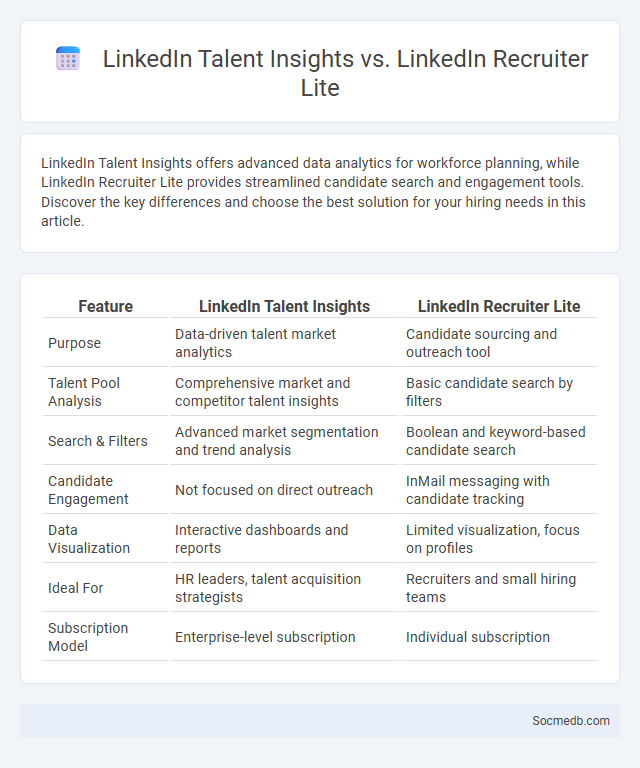
Photo illustration: LinkedIn Talent Insights vs LinkedIn Recruiter Lite
LinkedIn Talent Insights offers advanced data analytics for workforce planning, while LinkedIn Recruiter Lite provides streamlined candidate search and engagement tools. Discover the key differences and choose the best solution for your hiring needs in this article.
Table of Comparison
| Feature | LinkedIn Talent Insights | LinkedIn Recruiter Lite |
|---|---|---|
| Purpose | Data-driven talent market analytics | Candidate sourcing and outreach tool |
| Talent Pool Analysis | Comprehensive market and competitor talent insights | Basic candidate search by filters |
| Search & Filters | Advanced market segmentation and trend analysis | Boolean and keyword-based candidate search |
| Candidate Engagement | Not focused on direct outreach | InMail messaging with candidate tracking |
| Data Visualization | Interactive dashboards and reports | Limited visualization, focus on profiles |
| Ideal For | HR leaders, talent acquisition strategists | Recruiters and small hiring teams |
| Subscription Model | Enterprise-level subscription | Individual subscription |
Overview of LinkedIn Talent Insights
LinkedIn Talent Insights provides real-time data on workforce trends, talent pools, and competitor analysis, enabling recruiters and HR professionals to make informed decisions. The platform aggregates data from over 900 million LinkedIn members, offering insights into skills demand, hiring patterns, and geographic talent distribution. Businesses leverage these analytics to optimize talent acquisition strategies and improve workforce planning efficiency.
Key Features of LinkedIn Recruiter Lite
LinkedIn Recruiter Lite offers advanced search filters, enabling recruiters to pinpoint candidates based on skills, location, experience, and industry. It integrates messaging capabilities to contact potential hires directly through InMail, enhancing communication efficiency. The platform also includes candidate tracking tools to organize and manage talent pipelines effectively.
Understanding Talent Acquisition
Talent acquisition leverages social media platforms like LinkedIn, Twitter, and Facebook to identify and engage potential candidates through targeted content and strategic employer branding. Data analytics from social media interactions enable recruiters to assess candidate fit by analyzing profiles, endorsements, and activity patterns. Social media-driven recruiting improves reach, enhances candidate experience, and accelerates the hiring process by connecting employers with passive talent pools efficiently.
LinkedIn Talent Insights vs Recruiter Lite: Core Differences
LinkedIn Talent Insights provides deep analytics on talent pools and market trends, enabling data-driven recruitment strategies, while Recruiter Lite focuses on candidate sourcing with advanced search filters and InMail credits for personalized outreach. Talent Insights offers comprehensive dashboards and talent mapping tools for workforce planning, whereas Recruiter Lite streamlines daily hiring tasks with candidate recommendations and pipeline management. Organizations prioritize Talent Insights for macro-level market intelligence and Recruiter Lite for micro-level, hands-on recruitment activities.
Benefits of Using LinkedIn Talent Insights for Employers
LinkedIn Talent Insights provides employers with real-time data on talent pools, enabling informed hiring decisions and strategic workforce planning. You can identify skill gaps, benchmark competitors, and target the best candidates efficiently by leveraging detailed analytics on workforce trends and talent availability. This platform enhances recruitment effectiveness and boosts overall talent acquisition outcomes.
Recruiter Lite: Strengths and Limitations
Recruiter Lite offers powerful social media tools that streamline candidate searches by leveraging LinkedIn's extensive professional network, helping you identify potential hires quickly. Its strengths include advanced filters and insights that enhance candidate matching accuracy, boosting recruitment efficiency. However, limitations such as restricted search depth and limited integration with other social platforms may require supplementary tools to fully optimize talent acquisition.
The Role of Talent Acquisition in Modern Recruitment
Talent acquisition plays a crucial role in modern recruitment by leveraging social media platforms to identify and engage passive candidates with specialized skills. Advanced algorithms and data analytics enable recruiters to target talent pools more effectively, enhancing diversity and fit within organizations. Social media also facilitates employer branding, allowing companies to showcase culture and attract candidates aligned with their values.
Data-Driven Decisions: How Talent Insights Supports Talent Acquisition
Talent Insights leverages social media analytics to deliver data-driven decisions that enhance talent acquisition strategies. By analyzing engagement metrics, candidate behavior, and industry trends, it identifies high-potential candidates and optimizes recruitment campaigns. This approach improves targeting accuracy, reduces hiring time, and increases the quality of hires through actionable social media data.
Choosing the Right Tool: Insights vs Recruiter Lite for Talent Acquisition
Choosing the right social media tool for talent acquisition depends on your specific recruiting needs and budget. Insights provides comprehensive data analytics and candidate behavior patterns ideal for strategic decision-making, while Recruiter Lite offers streamlined search and outreach features suitable for smaller-scale recruitment efforts. Your choice should align with your hiring goals to maximize efficiency and candidate engagement.
Future Trends in Talent Acquisition and LinkedIn Solutions
Future trends in talent acquisition emphasize AI-driven recruitment tools and advanced analytics to enhance candidate matching and streamline hiring processes. LinkedIn Solutions is at the forefront, offering features like LinkedIn Talent Insights and AI-powered candidate recommendations to optimize talent sourcing and engagement. Integration of virtual reality for immersive candidate experiences and increased reliance on data-driven strategies are expected to redefine recruiting success.
 socmedb.com
socmedb.com